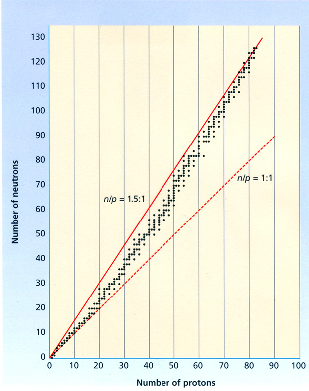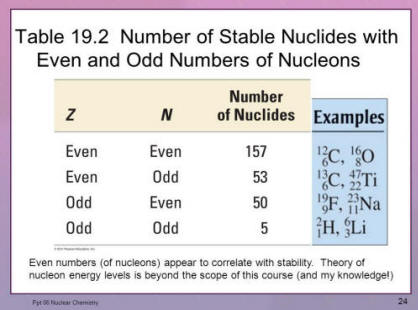 |  |
Stable nuclides, if plotted on a graph of number of protons vs. number of neutrons, would all fall in an area enclosed by two curved lines known as the band of stability. The band of stability also includes radionuclides because smooth lines cannot be drawn to exclude them. The band of stability also stops at element 83 because there are no known stable isotopes above it. Elements lying outside the band of stability would be too unstable to justify the time and money for an attempt to make it. Another thing that is noticed about the band of stability is that as the number of protons increases, the ratio of neutrons to protons increases. This is because more neutrons are needed to compensate for the increasing proton-proton repulsions. Isotopes occurring above and to the left of the band tend to be beta emitters because they want to lose a neutron and gain a proton. Those lying below and to the right of the band tend to be positron emitters because they want to lose a proton and gain a neutron. Isotopes above element 83 tend to be alpha emitters because they have too many nucleons. The Odd-Even RuleIn the odd-even rule, when the numbers of neutrons and protons in the nucleus are both even numbers, the isotopes tends to be far more stable than when they are both odd. Out of all the 264 stable isotopes, only 5 have both odd numbers of both, whereas 157 have even numbers of both, and the rest have a mixed number.
This has to do with the spins of nucleons. Both protons and neutrons spin. When two protons or neutrons have paired spins (opposite spins), their combined energy is less than when they are unpaired.
 The Magic NumbersAnother rule of nuclear stability is that isotopes with certain numbers of protons or neutrons tend to be more stable then the rest. These certain numbers are called the magic numbers, and they are, for reasons to detailed to explain here, 2, 8, 20, 28, 50, 82, and 126. When a nucleus has a number of protons and neutrons that are the same magic number, it is very stable. For example: 42He, 168O, and 4020Ca. One stable isotope of lead, 20882Pb, has 82 protons and 126 neutrons.The magic numbers: proton: 2, 8, 20, 28, 50, 82, 114 neutron: 2, 8, 20, 28, 50, 82, 126, 184 from-http://library.thinkquest.org/3659/nucreact/stability.html |

